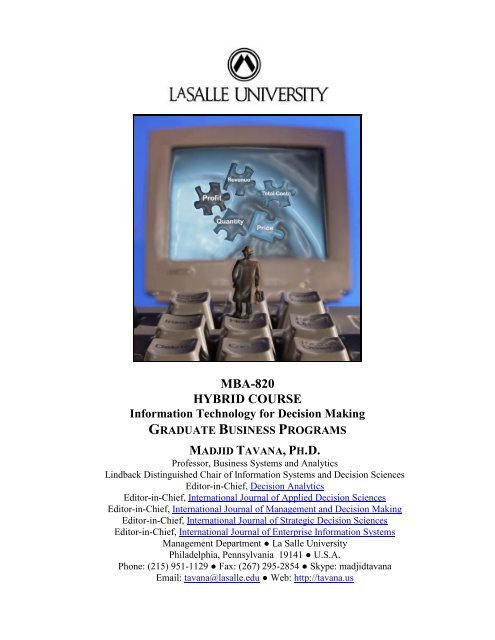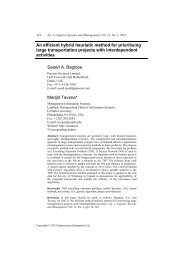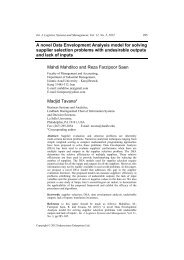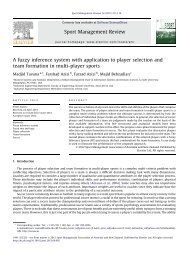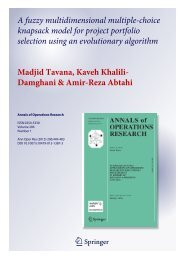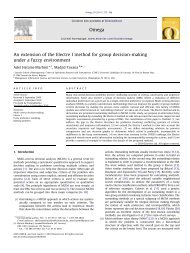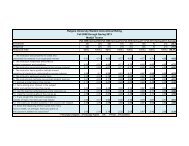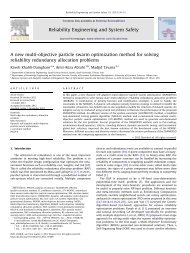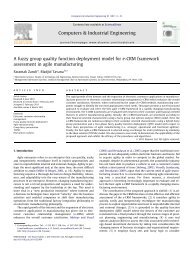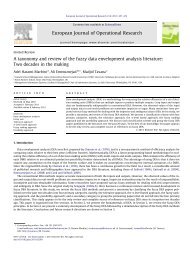MBA-820 - Dr. Madjid Tavana, Professor of Management Information ...
MBA-820 - Dr. Madjid Tavana, Professor of Management Information ...
MBA-820 - Dr. Madjid Tavana, Professor of Management Information ...
Create successful ePaper yourself
Turn your PDF publications into a flip-book with our unique Google optimized e-Paper software.
<strong>MBA</strong>-<strong>820</strong><br />
HYBRID COURSE<br />
<strong>Information</strong> Technology for Decision Making<br />
GRADUATE BUSINESS PROGRAMS<br />
MADJID TAVANA, PH.D.<br />
<strong>Pr<strong>of</strong>essor</strong>, Business Systems and Analytics<br />
Lindback Distinguished Chair <strong>of</strong> <strong>Information</strong> Systems and Decision Sciences<br />
Editor-in-Chief, Decision Analytics<br />
Editor-in-Chief, International Journal <strong>of</strong> Applied Decision Sciences<br />
Editor-in-Chief, International Journal <strong>of</strong> <strong>Management</strong> and Decision Making<br />
Editor-in-Chief, International Journal <strong>of</strong> Strategic Decision Sciences<br />
Editor-in-Chief, International Journal <strong>of</strong> Enterprise <strong>Information</strong> Systems<br />
<strong>Management</strong> Department ● La Salle University<br />
Philadelphia, Pennsylvania 19141 ● U.S.A.<br />
Phone: (215) 951-1129 ● Fax: (267) 295-2854 ● Skype: madjidtavana<br />
Email: tavana@lasalle.edu ● Web: http://tavana.us
1. PREREQUISITES:<br />
Completion <strong>of</strong> Foundation Courses<br />
2. COURSE DESCRIPTION:<br />
Managing <strong>Information</strong> Technology (IT) is no longer viewed as a back <strong>of</strong>fice, cost-dominated<br />
function. In many industries, IT has become a strategic requirement that consists <strong>of</strong> two related<br />
but competing activities: supporting the existing business and enabling new business. These two<br />
activities share a set <strong>of</strong> functional requirements, typically organized within the information<br />
systems (IS) department. But they also share a set <strong>of</strong> critical management issues, which transcend<br />
the IS function. This course is about the manager's responsibilities for problem solving and<br />
decision making, and those areas in which IT can be used to gain the insight needed to support<br />
selection <strong>of</strong> decision alternatives. The course focuses on data, information, and knowledge by<br />
utilizing a series <strong>of</strong> tools to develop Database <strong>Management</strong> Systems, <strong>Management</strong> <strong>Information</strong><br />
Systems, Decision Support Systems, and expert System in support <strong>of</strong> the decision making and<br />
problem solving processes in a hands-on environment.<br />
3. COURSE OBJECTIVES:<br />
Upon completion <strong>of</strong> prescribed work for this course, the student should be able to:<br />
Understand the emerging technological issues facing managers.<br />
Understand the value <strong>of</strong> data, information, and knowledge to organizations.<br />
Distinguish among Database <strong>Management</strong> Systems, <strong>Management</strong> <strong>Information</strong> Systems,<br />
Decision Support Systems, and expert System.<br />
Utilize IT to design competitive and efficient organizations.<br />
Describe the latest concepts, components, and applications <strong>of</strong> IT.<br />
Utilize IT tools to design operational, managerial, and strategic systems.<br />
Describe the leadership responsibilities and organizational impact <strong>of</strong> IT.<br />
Utilize a series <strong>of</strong> tools to design and develop Database <strong>Management</strong> Systems,<br />
<strong>Management</strong> <strong>Information</strong> Systems, Decision Support Systems, and expert System in support<br />
<strong>of</strong> the decision making and problem solving processes.<br />
Describe when and how <strong>Management</strong> Support Systems may be used to complement more<br />
analytic decision making frameworks.<br />
2
4. COURSE OVERVIEW:<br />
Computers are data, information, and knowledge processing machines. Billions <strong>of</strong> dollars are<br />
spent every year collecting, storing, processing, and retrieving data; whether it is for financial,<br />
marketing, or operational analysis and decision making. Data is a collection <strong>of</strong> bits, bytes, and<br />
characters. Raw data by itself has little or no use. No decision can be made without organizing<br />
and synthesizing data. <strong>Information</strong> is derived from organizing data and knowledge is extracted<br />
from synthesizing information. The evolution <strong>of</strong> data and its relationship with information and<br />
knowledge can be visualized as a pyramid <strong>of</strong> interdependent layers on the top <strong>of</strong> each other with<br />
data at the bottom, information in the middle, and knowledge on the top.<br />
Computers are used to collect, store, and process (organize and synthesize) data, information, and<br />
knowledge. Data is collected by a Transactional Processing System (TPS) and stored in a<br />
Database <strong>Management</strong> System (DBMS). Data is organized into information by an <strong>Information</strong><br />
System (IS) and used in a Decision Support System (DSS) for decision making. <strong>Information</strong> is<br />
organized, meaningful, and useful data. <strong>Information</strong> is synthesized into knowledge by a<br />
Knowledge Based system (KBS) and used in an Expert Systems (ES) for problem solving.<br />
3
Consider the scenario depicted in the pyramid below where a retailer collects data on their<br />
revenues and expenses every time a purchase is made or every time an expense is paid. That data<br />
is then stored in the retailer’s DBMS. The accounting department can retrieve and organize this<br />
data into meaningful information by way <strong>of</strong> a report such as income statement. The operations<br />
department can use this information in a DSS to assess pr<strong>of</strong>itability. The finance department can<br />
synthesize this information in a KBS and make expansion or contraction decisions.<br />
This course focuses on data, information, and knowledge by utilizing a series <strong>of</strong> tools to develop<br />
Database <strong>Management</strong> Systems, <strong>Management</strong> <strong>Information</strong> Systems, Decision Support Systems,<br />
and expert System in support <strong>of</strong> the decision making and problem solving processes in a handson<br />
environment.<br />
5. WEB RESOURCES:<br />
http://tavana.us/downloads/downloads.shtml<br />
username: tavana<br />
password: spacewalk<br />
4
6. COURSE TOPICS AND REQUIREMENTS:<br />
The World <strong>of</strong> <strong>Information</strong> Systems and Decision Sciences<br />
Decision Making in the <strong>Information</strong> Age<br />
Transactional Processing Systems and Databse <strong>Management</strong><br />
Database Managament Systems (SA-DBM-H)<br />
Building DBMS with ACCESS (SA-ACC-H)<br />
Cases:<br />
Happyville Casino<br />
Explorer Helthcare<br />
Great Times Summer Camp<br />
Jimmy “the Body Bag” Biggs<br />
Access Case Analysis (15% <strong>of</strong> the Final Grade):<br />
A PowerPoint Presentation with Problem Description, Initial Table, Split<br />
Tables, Relationships, and Query.<br />
SAMPLE ACCESS CASE & DATABASE.<br />
Decision Support Systems and Spreadsheets<br />
Decision Support Systems and EXCEL (DS-EXL-H)<br />
Cases:<br />
American Appliances<br />
The Heinrich Company<br />
Francois Stealth<br />
Planters Nut Company<br />
Titanic Cruise Company<br />
Built-4-U<br />
Rent-A-Wreck<br />
Golden Palace Casino<br />
Impulse Shopping Network<br />
Excel Case Analysis (15% <strong>of</strong> the Final Grade):<br />
A PowerPoint Presentation with Problem Description, Excel<br />
Spreadsheet, Solver Formulation, and Optimal Solution.<br />
SAMPLE EXCEL CASE & EXCEL FILE.<br />
5
Decision Support Systems and Natural Language Programming (Visit D-code.us)<br />
Natural Language Programming: D-code (DS-COL-H)<br />
Building DSS with D-code (DS-COP-H)<br />
Cases:<br />
Keystone Corporation<br />
The Prolog Corporation<br />
Starship Technologies<br />
<strong>Dr</strong>. Warped<br />
Jungle Jim<br />
D-code Case Analysis (15% <strong>of</strong> the Final Grade):<br />
A PowerPoint Presentation with Problem Description, Influence<br />
Diagram, Planners Lab Model, and Spreadsheet Solution.<br />
SAMPLE D-CODE CASE & D-code FILE.<br />
Decision Support Systems and Influence Diagramming (Visit D-cide.us)<br />
Influence Diagramming and D-cide (DS-DCD-H)<br />
Cases:<br />
The Procom Corporation<br />
Thrills R Us<br />
Parrot Club<br />
Southwest Airline<br />
Pick Your Own<br />
Jungle Jim<br />
D-cide Case Analysis (15% <strong>of</strong> the Final Grade):<br />
A PowerPoint Presentation with Problem Description,<br />
Diagram Screenshot, and Spreadsheet Solution.<br />
SAMPLE D-cide CASE & D-cide FILE.<br />
Influence<br />
Knowledge-Based Systems (Visit B-wise.us)<br />
Knowledge Engineering with B-wise (DS-BWL-H)<br />
Building Expert Systems with B-wise (DS-BWP-H)<br />
Cases:<br />
Check Cashing Problem<br />
6
College Hill Tavern<br />
Police Academy<br />
Corleone Family<br />
La Boutique<br />
Gateway Computers<br />
B-wise Case Analysis (15% <strong>of</strong> the Final Grade):<br />
A PowerPoint Presentation with Problem Description, A listing <strong>of</strong><br />
Factors and Choices, and Decision Tree Screenshot.<br />
SAMPLE B-wise CASE & B-wise FILE.<br />
Exam (20% <strong>of</strong> the Final Grade)<br />
A hands-on exam focusing on the systems described throughout the<br />
course (Open Book and Open Notes).<br />
Pr<strong>of</strong>essionalism (5% <strong>of</strong> the Final Grade)<br />
Pr<strong>of</strong>essionalism: The majority <strong>of</strong> this class is engaged in full time employment or is seeking to<br />
enhance their employment opportunities. I would like to help you enhance your career by asking<br />
you to behave as you would in a pr<strong>of</strong>essional setting. To do this, I suggest that you think <strong>of</strong> me as<br />
your manager, and our class sessions as regularly scheduled meetings. Following are some <strong>of</strong> the<br />
things that pr<strong>of</strong>essionals would never do:<br />
Miss a regularly scheduled meeting. People can’t always attend all meetings, but pr<strong>of</strong>essional<br />
courtesy dictates informing the manager ahead <strong>of</strong> time when a conflict has arisen. If you do<br />
need to miss class due to a conflict, please send me an email or call me before class and leave<br />
a message on my voice mail system.<br />
Arrive late for a meeting without explaining the circumstances ahead <strong>of</strong> time. I expect you to<br />
be on time for class, not saunter in five or ten minutes late.<br />
Leave early from a meeting, without explaining the circumstances ahead <strong>of</strong> time. If you need<br />
to leave early, let me know beforehand.<br />
Sleeping or being inattentive during a meeting. Can you imagine someone sleeping during a<br />
meeting with his/her manager? In my pr<strong>of</strong>essional experience, such behavior is never<br />
tolerated.<br />
Being unprepared or being unwilling to participate in class and group discussions. I expect<br />
you to come prepared for class and participate actively in class discussions and your group<br />
project.<br />
To encourage development <strong>of</strong> pr<strong>of</strong>essional habits I have based 10% <strong>of</strong> your total grade on<br />
pr<strong>of</strong>essionalism. You will receive a maximum <strong>of</strong> 5 pr<strong>of</strong>essionalism points per class - if you meet<br />
7
your manager's expectations. If you have an unexcused absence, you will not receive any<br />
pr<strong>of</strong>essionalism points for that class. Similarly, point reductions will be taken if you arrive late,<br />
leave early, sleep, or are unprepared/unwilling to participate.<br />
7. GRADING POLICY:<br />
Cases should be submitted through the following online submission system:<br />
Grades are sent to the students through email using the following evaluation form:<br />
Grading Criteria 0 1 2 3 4 5 6 7 8 9 10<br />
Originality/Creativity<br />
Presentation<br />
Problem Description<br />
Complexity<br />
Solution<br />
Overall score<br />
The student earns points which will be calculated on a 100 point scale. There is no extra credit.<br />
The following are the cut<strong>of</strong>f points for each grade:<br />
A Indicates the demonstration <strong>of</strong> a superior level <strong>of</strong> competency 93.0-100<br />
A- Indicates the demonstration <strong>of</strong> a very good level <strong>of</strong> competence 90.0-92.9<br />
B+ Indicates the demonstration <strong>of</strong> a good level <strong>of</strong> competency 87.0-89.9<br />
B Indicates the demonstration <strong>of</strong> an average, satisfactory level <strong>of</strong> competency 83.0-86.9<br />
B- Indicates the demonstration <strong>of</strong> a less than average level <strong>of</strong> competency 80.0-82.9<br />
C Indicates a below average and marginally satisfactory level <strong>of</strong> competency 70.0-79.9<br />
F Indicates failure to demonstrate a satisfactory level <strong>of</strong> competency 00.0-69.9<br />
8. ACADEMIC INTEGRITY POLICY:<br />
La Salle University is a community <strong>of</strong> shared academic values, foremost <strong>of</strong> which is a strong<br />
commitment to intellectual honesty, honorable conduct, and respect for others. In order to meet<br />
these values, students are expected to adhere to the highest standards <strong>of</strong> academic integrity.<br />
These standards are embodied in the La Salle University Academic Integrity Policy and are<br />
available online at: http://tavana.us/AIP.pdf<br />
8
Click Here to open and fill out your data sheet. Please return or email your<br />
completed data sheet to your instructor during the first week <strong>of</strong> classes.<br />
9


